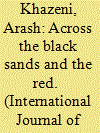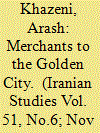| Srl | Item |
| 1 |
ID:
101168


|
|
|
|
|
| Publication |
2010.
|
| Summary/Abstract |
Through a reading of 19th-century Persian travel narratives, this article locates the history of Iran and Central Eurasia within recent literature on global frontier processes and the encounter between empire and nature. It argues that Persianate travel books about Central Eurasia were part of the imperial project to order and reclaim the natural world and were forged through the material encounter with the steppes. Far from a passive act of collecting information and more than merely an extension of the observer's preconceptions, description was essential to the expansion and preservation of empire. Although there exists a vast literature on Western geographical and ethnographic representations of the Middle East, only recently have scholars begun to mine contacts that took place outside of a Western colonial framework and within an Asian setting. Based on an analysis of Riza Quli Khan Hidayat's Sifaratnama-yi Khvarazm, the record of an expedition sent from the Qajar Dynasty to the Oxus River in 1851, the article explores the 19th-century Muslim "discovery" of the Eurasian steppe world. The expedition set out to define imperial boundaries and to reclaim the desert, but along the way it found a permeable "middle ground" between empires, marked by transfrontier and cross-cultural exchanges.
|
|
|
|
|
|
|
|
|
|
|
|
|
|
|
|
| 2 |
ID:
162786


|
|
|
|
|
| Summary/Abstract |
This paper provides a translation and analysis of Sloane Mss. 3259 in the British Library, a Persian farmān from the court of King Chandrawizaya Rājā in the Arakanese Kingdom of Mrauk U (1429−1784). Written in 1728 and addressed to the Armenian merchant Khwājeh Georgin of the port of Chennaipattana across the Bay of Bengal in India, the decree is a permit for the lucrative trade in elephants and ivory from the forests of Arakan. The royal decree reveals the presence of Persian as a mutual language of encounter, exchange, diplomacy, and correspondence in eighteenth-century Southeast Asia. Through the manuscript, a view emerges of a sovereign forest kingdom of manifold rarities at the margins of the Persianate and Mughal worlds.
|
|
|
|
|
|
|
|
|
|
|
|
|
|
|
|